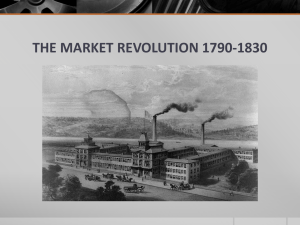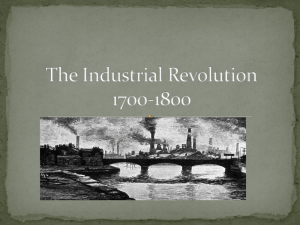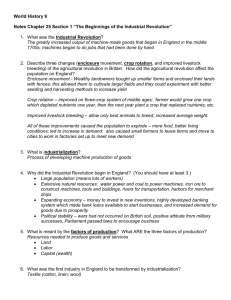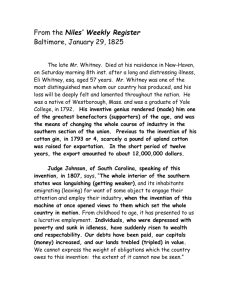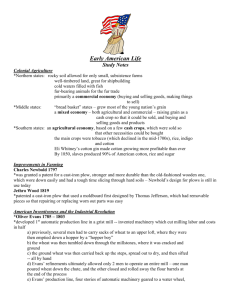File
advertisement
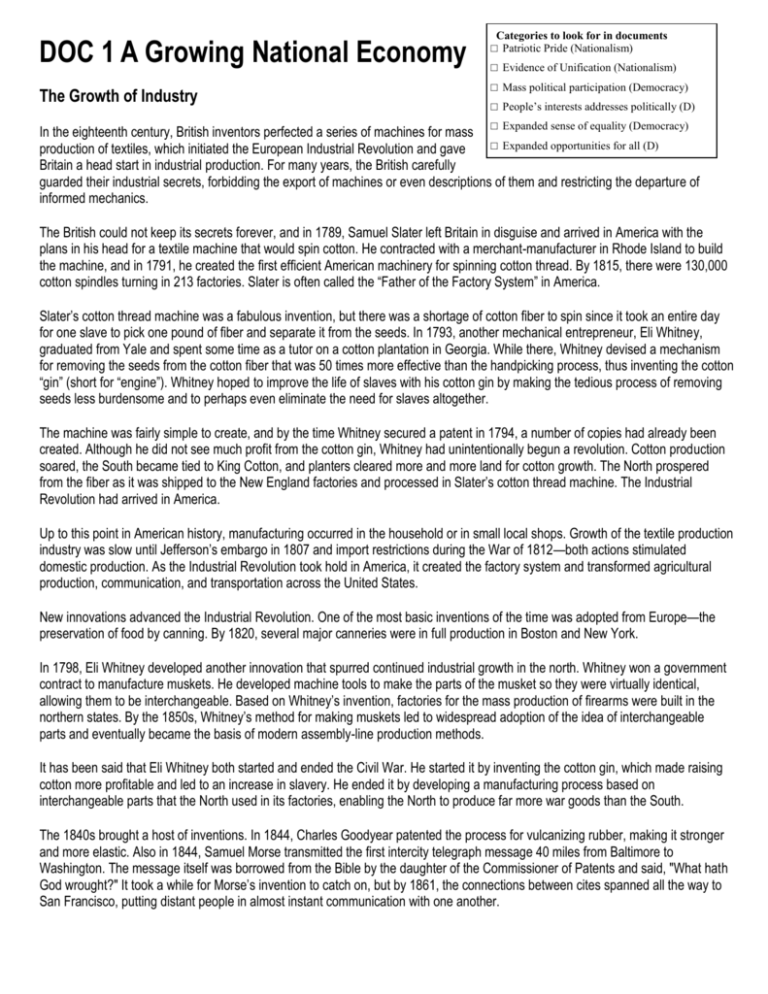
DOC 1 A Growing National Economy Categories to look for in documents □ Patriotic Pride (Nationalism) The Growth of Industry □ Mass political participation (Democracy) □ Evidence of Unification (Nationalism) □ People’s interests addresses politically (D) In the eighteenth century, British inventors perfected a series of machines for mass □ Expanded sense of equality (Democracy) □ Expanded opportunities for all (D) production of textiles, which initiated the European Industrial Revolution and gave Britain a head start in industrial production. For many years, the British carefully guarded their industrial secrets, forbidding the export of machines or even descriptions of them and restricting the departure of informed mechanics. The British could not keep its secrets forever, and in 1789, Samuel Slater left Britain in disguise and arrived in America with the plans in his head for a textile machine that would spin cotton. He contracted with a merchant-manufacturer in Rhode Island to build the machine, and in 1791, he created the first efficient American machinery for spinning cotton thread. By 1815, there were 130,000 cotton spindles turning in 213 factories. Slater is often called the “Father of the Factory System” in America. Slater’s cotton thread machine was a fabulous invention, but there was a shortage of cotton fiber to spin since it took an entire day for one slave to pick one pound of fiber and separate it from the seeds. In 1793, another mechanical entrepreneur, Eli Whitney, graduated from Yale and spent some time as a tutor on a cotton plantation in Georgia. While there, Whitney devised a mechanism for removing the seeds from the cotton fiber that was 50 times more effective than the handpicking process, thus inventing the cotton “gin” (short for “engine”). Whitney hoped to improve the life of slaves with his cotton gin by making the tedious process of removing seeds less burdensome and to perhaps even eliminate the need for slaves altogether. The machine was fairly simple to create, and by the time Whitney secured a patent in 1794, a number of copies had already been created. Although he did not see much profit from the cotton gin, Whitney had unintentionally begun a revolution. Cotton production soared, the South became tied to King Cotton, and planters cleared more and more land for cotton growth. The North prospered from the fiber as it was shipped to the New England factories and processed in Slater’s cotton thread machine. The Industrial Revolution had arrived in America. Up to this point in American history, manufacturing occurred in the household or in small local shops. Growth of the textile production industry was slow until Jefferson’s embargo in 1807 and import restrictions during the War of 1812—both actions stimulated domestic production. As the Industrial Revolution took hold in America, it created the factory system and transformed agricultural production, communication, and transportation across the United States. New innovations advanced the Industrial Revolution. One of the most basic inventions of the time was adopted from Europe—the preservation of food by canning. By 1820, several major canneries were in full production in Boston and New York. In 1798, Eli Whitney developed another innovation that spurred continued industrial growth in the north. Whitney won a government contract to manufacture muskets. He developed machine tools to make the parts of the musket so they were virtually identical, allowing them to be interchangeable. Based on Whitney’s invention, factories for the mass production of firearms were built in the northern states. By the 1850s, Whitney’s method for making muskets led to widespread adoption of the idea of interchangeable parts and eventually became the basis of modern assembly-line production methods. It has been said that Eli Whitney both started and ended the Civil War. He started it by inventing the cotton gin, which made raising cotton more profitable and led to an increase in slavery. He ended it by developing a manufacturing process based on interchangeable parts that the North used in its factories, enabling the North to produce far more war goods than the South. The 1840s brought a host of inventions. In 1844, Charles Goodyear patented the process for vulcanizing rubber, making it stronger and more elastic. Also in 1844, Samuel Morse transmitted the first intercity telegraph message 40 miles from Baltimore to Washington. The message itself was borrowed from the Bible by the daughter of the Commissioner of Patents and said, "What hath God wrought?" It took a while for Morse’s invention to catch on, but by 1861, the connections between cites spanned all the way to San Francisco, putting distant people in almost instant communication with one another. In 1846, Elias Howe invented the sewing machine, which was then perfected by Isaac Singer. This invention gave another boost to northern industrialization, specifically the ready-made clothing industry. Machine-made clothes fit better and were less expensive than homespun clothes. The sewing machine also opened up a new line of employment for women, who began working in the clothing factories. The many technical advances shaped all aspects of Americans’ lives—social, cultural, political, and economic. Living conditions were improved with luxuries such as central heat, indoor plumbing, underground water lines, sewer systems, and improved lighting. Technological advances spurred laws of “free incorporation,” allowing corporations to be created without applying for individual charters from the legislature. Various regions of the north began to specialize in specific industries based on their locations and the availability of natural resources. For example, New England became the center for textile mills, while Pennsylvania led in production of iron. As these innovations and technical advances were taking place, the Boston Associates, a group of merchants headed by Francis Cabot Lowell, added a new dimension to factory production. Many of the early factories used Samuel Slater’s cotton spinning machines and set up hand looms, but the weavers could not keep up with the machines. In 1813, in Waltham, Massachusetts, Lowell combined the spinning machines with power weaving machines at the Boston Manufacturing Company plant. Lowell focused on mechanization of the entire process for mass-producing standardized cloth. The cloth was plain and rather coarse, but durable and cheap. The Boston Associates used the Boston Manufacturing Company as a model for new factories. In 1823, they harnessed the power of the Merrimack River at East Chelmsford, Massachusetts to develop a new plant. The town was appropriately renamed Lowell and within three years had over 2,000 inhabitants. By 1850, factories based on the Waltham model produced one-fifth of the nation’s total output of cotton cloth. In the new Lowell textile factories, the Boston Associates developed a labor system that employed young, unmarried women. By the 1820s, young women came to the factory towns from farms all over New England. The women lived in boardinghouses that were strictly supervised, and they earned between $2.50 and $3.25 per week, about half of which went for room and board. Often, the young women were not working to support themselves, but sending most of the money they made back home. Many worked simply for the excitement of meeting new people and to escape the confines of the farm for a few years before they married. A variety of educational and cultural opportunities offset, to some degree, unsafe and unhealthy conditions during the twelve-hour days and sixday workweeks. As the Lowell factories experienced booming growth, the conditions for the workers changed. The cities in which the textile factories operated became dirty, bleak industrial cities. Wage cuts and deteriorating working conditions became the norm. As the demand for cheap labor grew, child workers also became vulnerable to exploitation in the factories. Over half of the nation’s industrial workers in 1820 were children under the age of 10 who were both physically and mentally abused. Factory owners increasingly turned to Irish and German immigrants to operate their machines. During the 1830s and 1840s, textile prices and mill wages dropped. Workers organized strikes where they “turned out” to protest 12hour work days, wage cuts, and increasing costs for room and board. Although the protests were well attended, they did not force a reversal of management policy. Skilled artisans and craftsmen could no longer compete with the low prices and high volume of factory goods, and many were forced to take factory jobs. The influx of these skilled workers into the workforce renewed the demand for better working conditions and a shorter workday. Prompted by the moniker, “Northern wage slave,” many laborers undertook efforts to establish unions and create political organizations dedicated to advancing the interests of workers. In a landmark decision by the Massachusetts Supreme Court in the case of Commonwealth v. Hunt (1842), the court ruled that forming a trade union was not illegal. While on the surface this ruling looked to be significant for organized labor, it soon proved to be more of a symbolic gesture. Trade unions provided only marginal benefits for the workers of this time, and it would be nearly a century before they could meet management on even terms. By 1850, Samuel Slater’s factory system had been fine-tuned, and industry was booming in the east. The New England and the midAtlantic states had become the main centers of manufacturing and commerce. The primary products coming from the industrial centers in the north and mid-Atlantic at the time were textiles, lumber, clothing, machinery, and woolen goods.




